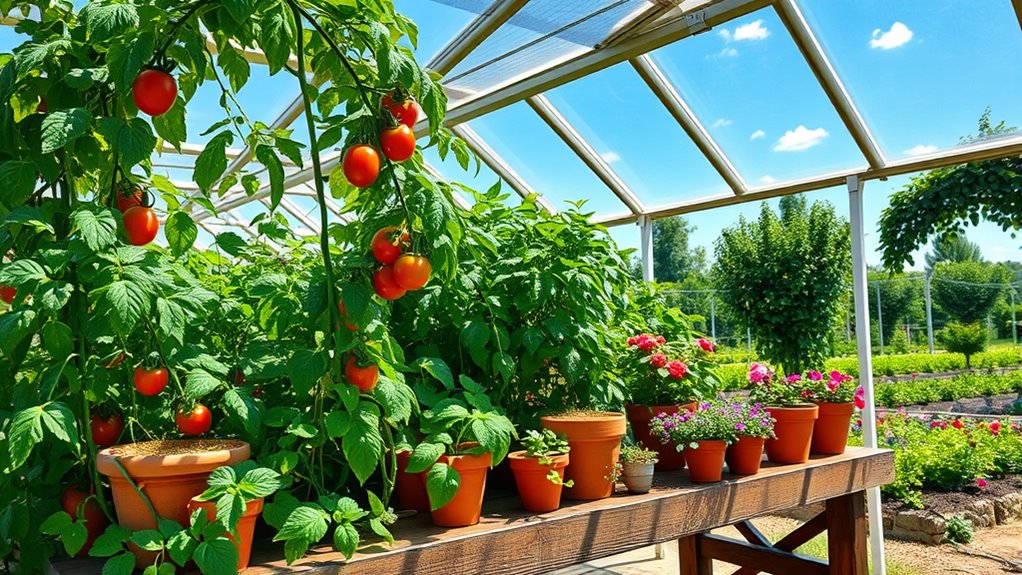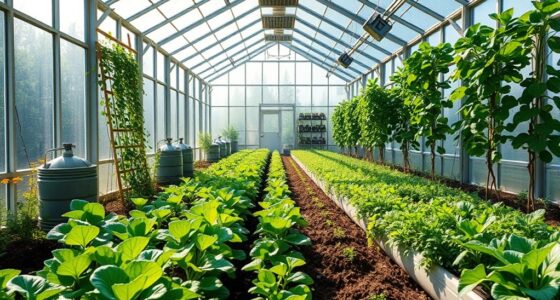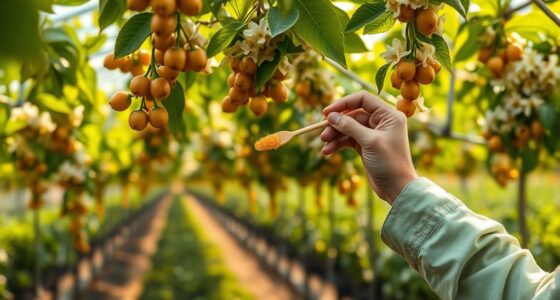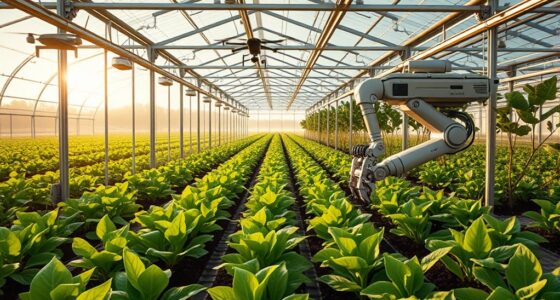Greenhouses are essential for sustainable agriculture, helping you maximize resources while reducing environmental impact. They efficiently use energy, with innovations like LED lighting and renewable energy sources cutting consumption. Sustainable practices, such as drip irrigation and composting, enhance water conservation and waste management. You'll also enjoy greater yields and protect crops from extreme weather within controlled environments. Discover how technology and new methods can further enhance greenhouse sustainability as you explore the exciting potential of these structures.
Key Takeaways
- Greenhouses enhance crop yields by providing controlled environments, allowing for multiple harvests and extended growing seasons regardless of local climate conditions.
- Sustainable practices in greenhouses include water conservation techniques, such as drip irrigation and rainwater harvesting, which optimize resource use.
- Energy-efficient technologies like LED lighting, high-insulation materials, and renewable energy sources minimize energy consumption and reduce greenhouse gas emissions.
- Integrated Pest Management (IPM) promotes ecological balance by combining various pest control methods, reducing reliance on chemical pesticides.
- Innovative growing methods, such as hydroponics and vertical farming, maximize space and promote sustainability in food production.
Energy Consumption in Greenhouses
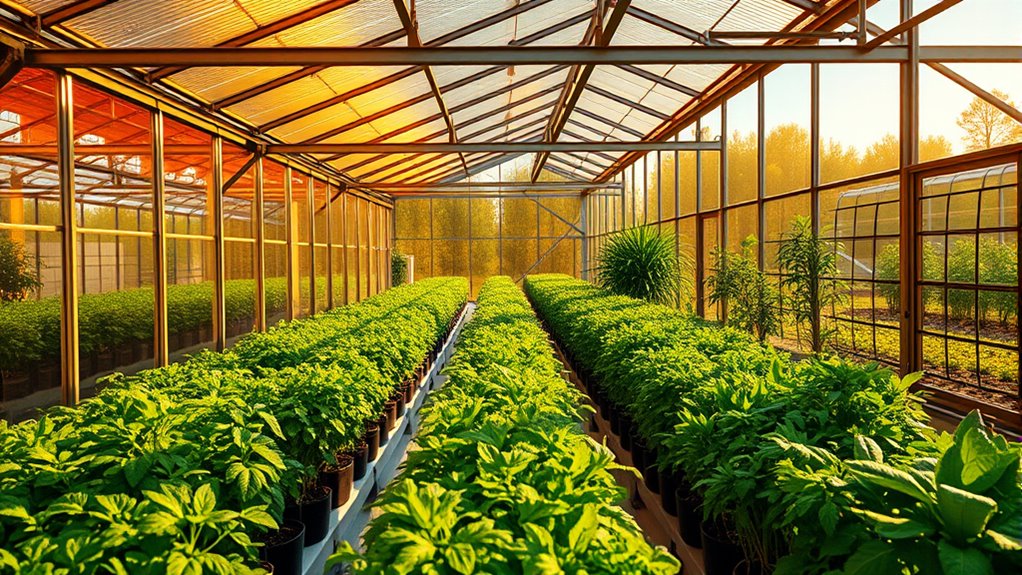
While managing a greenhouse, it's crucial to understand that energy consumption can be significant, particularly in regions like Finland, where greenhouse operations consumed 1,706 GWh in 2021.
Electricity plays a major role, with 619 GWh used solely for lighting, especially when supplemental lighting supports year-round production. Heating systems account for 311 GWh, while purchased heat energy, including renewable biomass, adds another 274 GWh. Photovoltaic systems can generate between 10 to 35 kWh/sq ft-yr, making them a viable option for reducing overall energy consumption. Additionally, utilizing solar energy can provide substantial economic benefits through reductions in energy costs and job creation in the renewable sector. Implementing sustainable practices in greenhouse management can further enhance energy efficiency and reduce environmental impact. Mixed herds of sheep and goats can also benefit greenhouse operations by providing natural fertilizers and improving soil health.
Efficient cooling methods like ventilation and shading are necessary to maintain ideal temperatures. As you move forward, consider integrating energy-efficient technologies like LED lighting and refining your systems to reduce electricity consumption.
Recognizing these aspects will guide you in managing energy use effectively, helping you create a more sustainable greenhouse operation.
Sustainable Practices in Greenhouse Operations

Energy efficiency is just one piece of the puzzle when it comes to running a sustainable greenhouse. You can enhance your operations by using sustainable materials like reclaimed wood or recycled plastic panels, which reduce waste and improve insulation. Implementing water conservation techniques, such as drip irrigation and rainwater harvesting, guarantees you use resources wisely. Explore innovative growing methods like hydroponics and vertical farming to maximize space and minimize water use. For waste management, establish recycling programs and composting to turn plant debris into valuable fertilizer. Additionally, the use of integrated pest management strategies that rely on natural controls rather than chemicals promotes a healthier ecosystem. These practices not only benefit the environment but also help you run a more efficient greenhouse, as energy-efficient materials contribute to lowering overall energy consumption. Furthermore, incorporating sustainable practices into your greenhouse design not only supports the environment but also enhances the longevity of your structure. Finally, using dry, seasoned wood in any heating systems can further enhance energy efficiency and reduce emissions.
Yield Advantages of Greenhouses
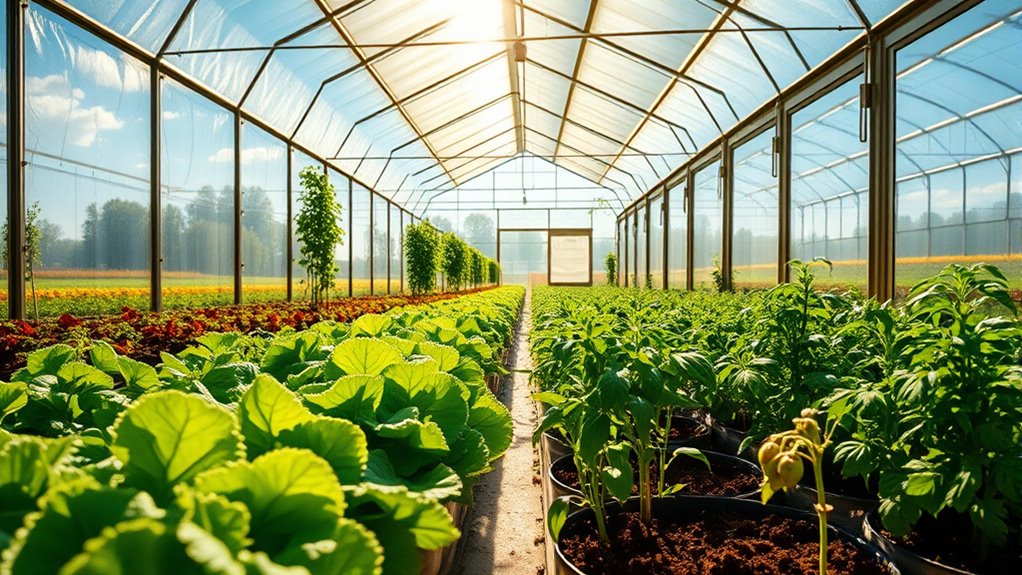
Greenhouses offer considerable yield advantages that can transform your growing operations.
With the ability to extend the growing season, you can plant earlier and achieve multiple harvests each year. The controlled environment within a greenhouse results in higher yields per square foot compared to traditional farming methods. Additionally, this setup allows for the cultivation of crops that require longer growth periods, maximizing the use of available land throughout the year. Implementing goal setting strategies can further optimize your growing processes and enhance productivity. For instance, growing crops like broccoli can be particularly advantageous in a greenhouse due to its optimal growing conditions. Furthermore, understanding primitive weapons can aid in deterring wildlife that may threaten your crops.
You'll also benefit from temperature regulation, protecting your crops from extreme weather, which minimizes crop loss.
Furthermore, greenhouses provide versatility, allowing you to grow a wide variety of crops regardless of local climate conditions.
These factors not only enhance your productivity but also increase your profitability, making it easier to meet market demands and maintain strong supplier relationships.
Embracing greenhouse technology can greatly boost your agricultural success.
Water Conservation Techniques
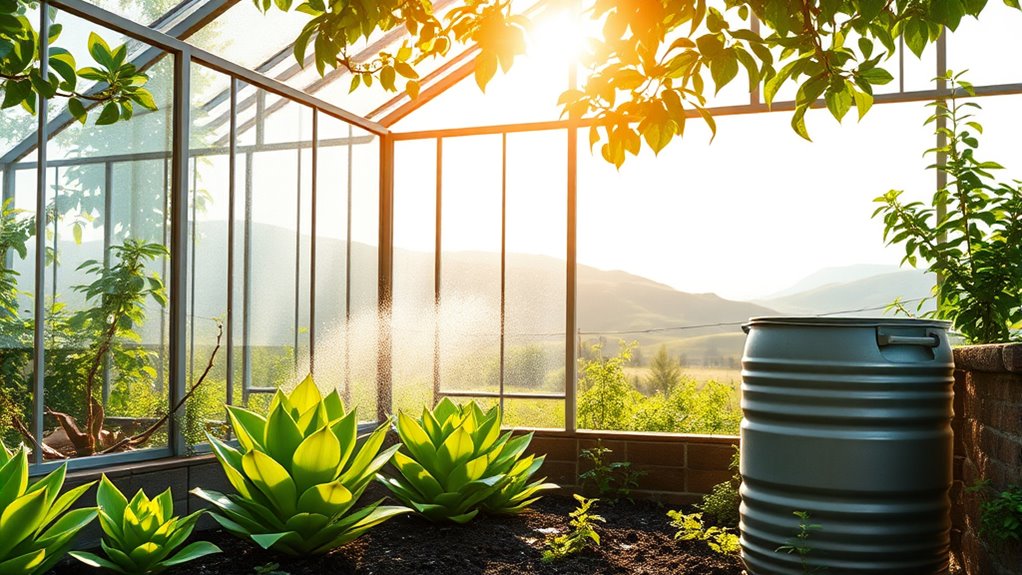
Water conservation techniques play an essential role in maximizing efficiency and sustainability in greenhouse operations.
By implementing drip irrigation, you can deliver water directly to plant roots, minimizing runoff and waste. Rainwater harvesting provides an alternative irrigation source, reducing your reliance on groundwater. Additionally, closer plant spacing can further decrease water consumption, ensuring that plants thrive without excessive watering. Establishing clear rules for irrigation schedules can also enhance water conservation efforts. Incorporating energy monitoring features into your irrigation system can help track water usage and optimize efficiency. Utilizing high refresh rates in monitoring systems can significantly improve response times for irrigation adjustments.
Consider using grey water recycling to supplement irrigation needs, while soil moisture sensors help you monitor moisture levels for peak watering. Covering soil with mulch reduces evaporation and weed growth, conserving water.
Additionally, timing your irrigation for morning guarantees plants receive water when they need it most. Regular maintenance of your irrigation systems prevents leaks, further enhancing water use.
These techniques not only improve sustainability but also contribute to healthier plants and more productive greenhouse environments.
Reducing Pesticide Use
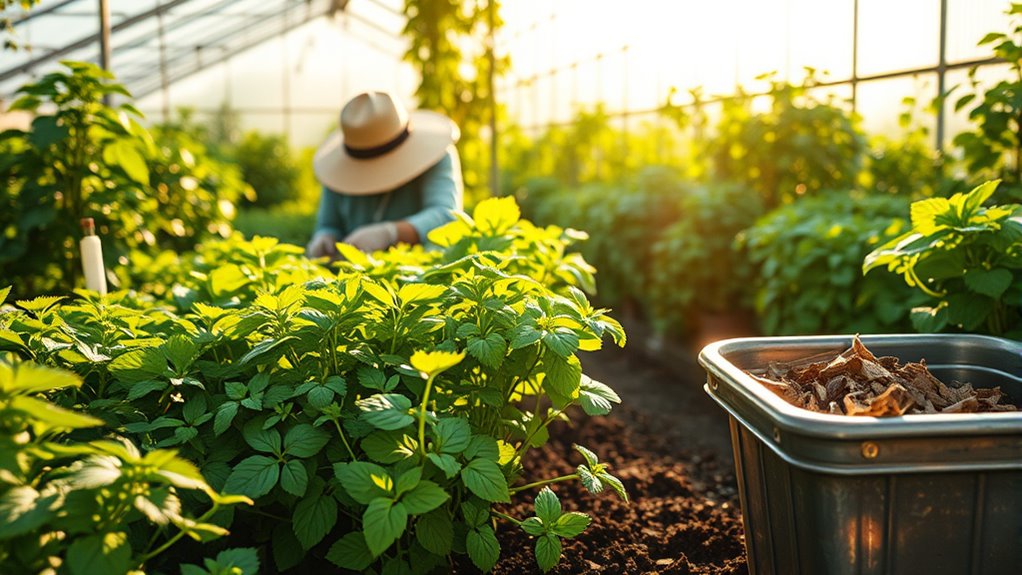
While you may rely on pesticides to manage pests in your greenhouse, reducing their use can lead to healthier plants and a more sustainable environment. Pesticide resistance is a growing concern, making it essential to explore alternatives. Implementing Integrated Pest Management (IPM) combines biological, cultural, physical, and chemical controls to minimize pesticide reliance. Consider using beneficial insects like predatory mites and lacewings for biological control. Maintaining sanitation practices and monitoring pest populations can also help you intervene early, reducing unnecessary applications. By developing economic thresholds, you can determine when pesticide use is genuinely necessary. Regular monitoring helps detect early infestations and manage pest populations, further enhancing your pest management strategies. Embracing these strategies not only protects your crops but also contributes to a healthier ecosystem, especially as software quality assurance methods can enhance the assessment of pest management systems. Additionally, ensuring adequate nutrition for your plants contributes to their overall resilience against pests and diseases. Moreover, understanding narcissistic tendencies can help in recognizing manipulative patterns in gardening practices that may lead to unsustainable methods.
Innovations in Energy Efficiency
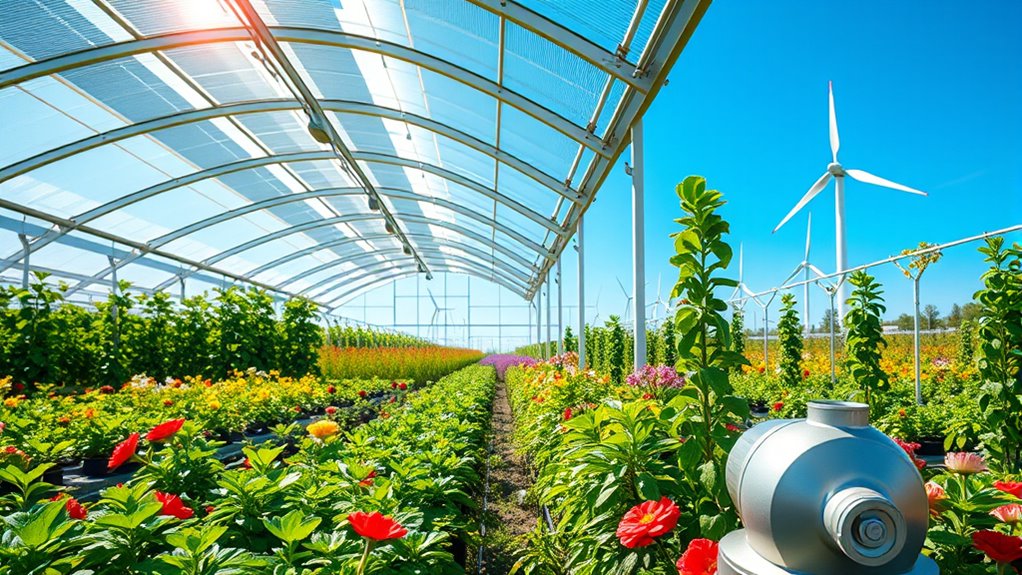
As the demand for sustainable practices grows, innovations in energy efficiency are becoming essential for greenhouse operations. You can enhance energy efficiency by utilizing high-insulation materials and proper glazing, which minimize energy loss while maximizing natural light. Consider semi-enclosed structures that retain heat longer, reducing heating needs. Geothermal heating eliminates fossil fuels, while heat pumps provide dual heating and cooling solutions, offering up to 50% energy bill reduction. Technologies like EC fans optimize airflow without excessive energy use, and thermal energy storage allows you to utilize excess summer heat in winter. Additionally, frost-free technology can be integrated into greenhouse operations to improve efficiency and reduce maintenance needs. Integrating renewable energy sources, like transparent solar panels, further reduces your carbon footprint. Additionally, the transition to resource-efficient and climate-friendly technologies is crucial for sustainable greenhouse operations. Commercial heat pumps are particularly beneficial due to their higher capacity and durability, making them ideal for larger greenhouse setups.
Environmental Benefits of Greenhouses
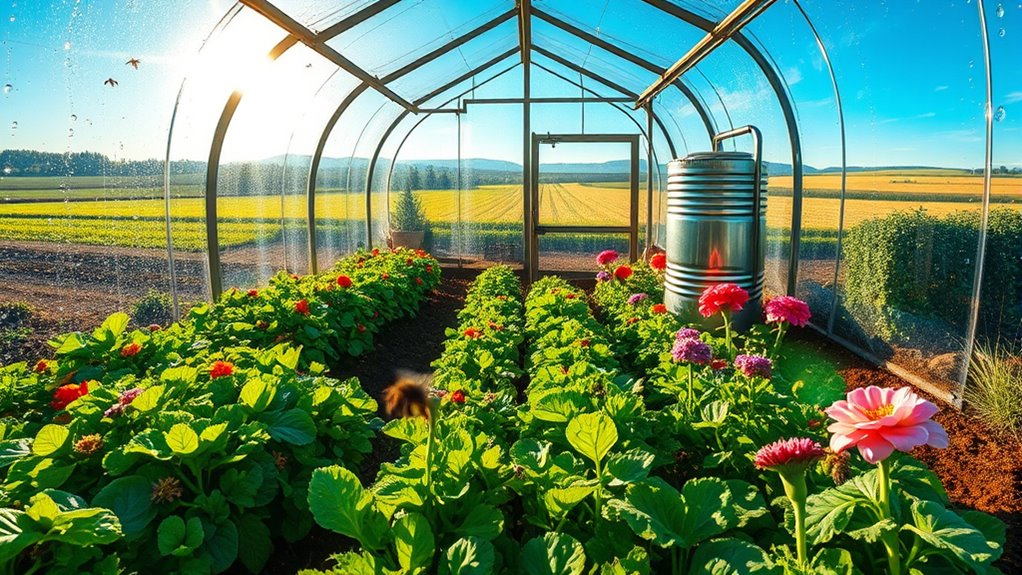
Greenhouses offer significant environmental benefits that align with the growing demand for sustainable agricultural practices. They conserve water by minimizing evaporation and utilizing efficient irrigation systems, like drip irrigation. Additionally, DIY Fire Pit Ideas can be incorporated into greenhouse designs to create outdoor spaces that enhance the gardening experience. Greenhouses can also utilize natural materials like wood and stone in their construction, contributing to a more sustainable building approach.
With land use efficiency, greenhouses allow for intensive farming, preserving natural habitats. Their reflective surfaces can increase albedo, contributing to local climate regulation. Moreover, controlled environment in greenhouses enables optimal plant growth, further enhancing their sustainability. This enhanced growth can be attributed to the mental clarity gained from organized gardening spaces, which fosters a more focused approach to cultivation.
By optimizing crop growth and reducing chemical inputs, greenhouses help minimize waste and environmental impact. Additionally, they promote biodiversity preservation by managing pests internally, reducing reliance on harmful external controls.
Using eco-friendly materials and practices, like rainwater harvesting and composting, further enhances their sustainability.
The Role of Technology in Greenhouse Management
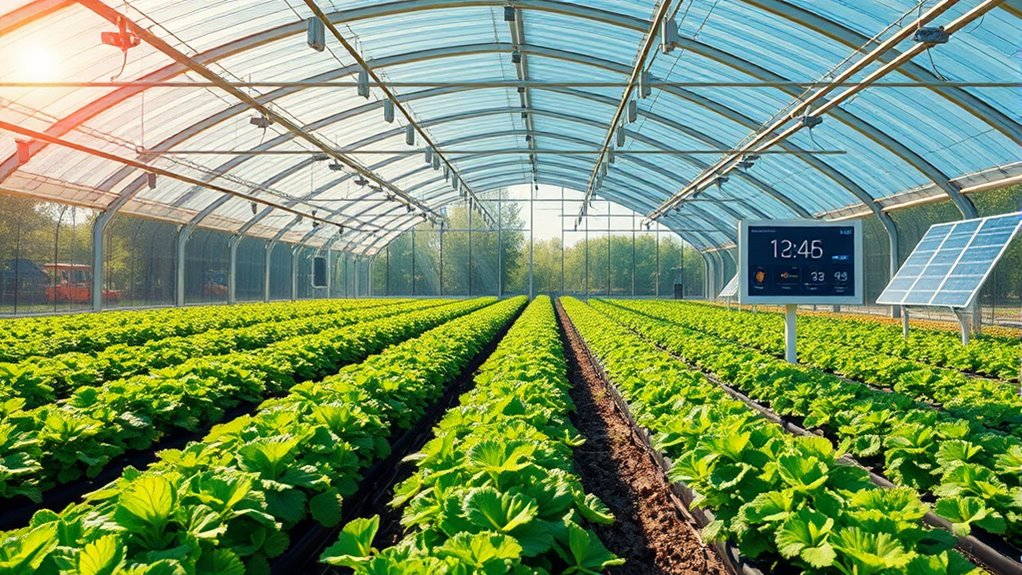
Technology plays an essential role in enhancing greenhouse management, improving both efficiency and sustainability.
With advanced ventilation systems, you can equalize climate conditions for ideal crop growth. Multiple heating layers help retain heat, cutting energy costs considerably. Larger greenhouses reduce labor energy costs and allow for automation, further increasing efficiency. Additionally, implementing smart irrigation systems can significantly lower water consumption while optimizing plant health. Understanding production quantity variance is also vital for maximizing resource utilization in greenhouse operations. Incorporating smart technologies allows for better decision-making based on data-driven insights.
Smart irrigation systems, utilizing rainwater harvesting, can reduce water usage by up to 98%. AI-powered sensors monitor conditions 24/7, enabling real-time adjustments that maintain plant health.
LED grow lights provide tailored light spectra, promoting year-round production while lowering energy consumption.
Robotics streamline tasks like pollination and harvesting, reducing labor and waste.
Global Impact of Greenhouse Adoption

While the global adoption of greenhouses offers numerous benefits, it also greatly impacts sustainability and climate change mitigation. Greenhouses can enhance agricultural efficiency, yet they're part of a larger emissions landscape.
As global greenhouse gas emissions rose by 1.2% in 2023, major emitters like China, the US, and India continue to contribute considerably. Even though some economies are successfully decoupling growth from emissions, sectors like agriculture still face challenges in reducing their carbon footprint. The US achieved 2.5% economic growth while reducing energy CO2 emissions by 2.6%. The integration of renewable energy sources in greenhouse operations can significantly reduce overall emissions and enhance sustainability efforts.
The greenhouse effect intensifies with rising emissions, leading to extreme weather and sea-level rise. To combat these issues, adopting sustainable practices within greenhouse management is essential, as it can play a key role in achieving net-zero emissions and addressing climate change impacts.
Future Directions for Greenhouse Sustainability

As the push for sustainability intensifies, the future of greenhouse operations hinges on innovative practices and technologies that minimize environmental impact.
You can harness solar panels and geothermal heating to cut carbon emissions while using energy-efficient materials to optimize energy consumption.
Implementing drip irrigation and exploring atmospheric water harvesting will guarantee efficient water usage.
Drip irrigation and atmospheric water harvesting ensure optimal water efficiency for sustainable greenhouse operations.
Integrating AI and robotics will automate tasks, enhancing efficiency and reducing labor costs.
Embrace hydroponics and aquaponics for sustainable farming methods.
By adopting recycled materials and passive solar designs, you'll create eco-friendly structures.
Finally, supporting policies aimed at zero emissions and collaborative research initiatives will further drive sustainability in greenhouse operations, paving the way for a greener future.
Frequently Asked Questions
What Types of Crops Are Best Suited for Greenhouse Cultivation?
When considering crops for greenhouse cultivation, you'll find that tomatoes, peppers, and cucumbers thrive in controlled environments.
Leafy greens like spinach, kale, and lettuce also do well year-round.
For fruits, strawberries and raspberries benefit from extended seasons, while melons and citrus enjoy the warmth.
Specialty crops like cannabis and cut flowers can be profitable too.
Choose crops that align with your climate and desired harvest frequency for the best results.
How Do Greenhouses Impact Local Ecosystems and Wildlife?
Greenhouses can greatly influence local ecosystems and wildlife. For instance, they can support biodiversity by offering a controlled environment for endangered plant species.
However, if not integrated thoughtfully, they might disrupt natural habitats. Notably, studies show that increased vegetation around greenhouses attracts beneficial insects, enhancing pollination.
While greenhouses improve air quality by absorbing CO2, construction noise can disturb local wildlife, making it essential to balance development with ecological considerations.
What Are the Initial Costs of Setting up a Greenhouse?
When setting up a greenhouse, your initial costs can range from $5,000 to over $200,000, depending on size and type. A small hobby greenhouse might cost between $5,000 and $12,000, while commercial setups start around $60,000.
Consider material choices, as glass is pricier but more durable.
Don't forget about site preparation, permits, and utility setup, which can add to your overall investment considerably.
Planning ahead can help you manage these expenses effectively.
How Do Seasonal Changes Affect Greenhouse Operations?
Imagine your greenhouse as a dynamic orchestra, each season a different conductor guiding the plants' growth.
As seasons shift, you adjust your crop scheduling, planting onions in early spring and cool-weather varieties in winter. You fine-tune insulation and lighting, ensuring your plants thrive despite chilly nights.
Adapting to market demands keeps your harvests relevant, while crop rotation rejuvenates the soil, allowing your greenhouse to perform harmoniously year-round, yielding vibrant and sustainable results.
Can Greenhouses Be Built in Urban Environments?
Yes, you can build greenhouses in urban environments. They utilize rooftops or vacant lots, maximizing limited space while providing fresh produce.
By reducing transportation emissions, they help lower carbon footprints. Although initial costs can be high, the long-term benefits, like food security and community engagement, make them worthwhile.
With innovative designs and sustainable practices, urban greenhouses not only enhance aesthetics but also contribute positively to local economies and education.
Conclusion
In the grand tapestry of agriculture, greenhouses weave sustainability into every thread. By embracing energy-efficient practices, conserving water, and reducing pesticide use, you're not just nurturing plants; you're cultivating a greener future. With technology as your ally, the possibilities bloom like vibrant flowers in spring. As you step into this world, remember that every choice you make contributes to a thriving planet. So, let's grow together and transform the landscape of farming for generations to come!
